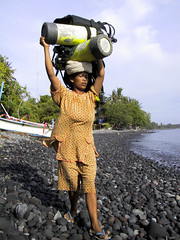
The beach here is rocky, and therefore so not so great for sunbathing, but it is great for diving. You can just walk right out into the water and you're pretty much on one of the two coral reefs or the shipwreck. They have the Coral Garden, a more beginner-friendly coral reef, and The Wall, a drop-off covered in coral. For the diving course, we had two pool dives and four ocean dives. Because we were comfortable and able to do all of the exercises fairly quickly and easily in the pool, we only did two pool sessions instead of the possible four or five. The dive course had homework, including watching a DVD, reading the large textbook, and answering quizzes to make sure we understood the basics of diving, the mechanics of our equipment, solutions and warning signs for possible problems, and the basics of underwater navigation and communication. A lot of this was common sense or things that we already knew, like the physics of buoyancy, so wasn't too difficult though it did take a good couple of hours each day.

While in the pool, you have to show that you won't freak out underwater, that you can figure out how to swim and use your equipment, and that if something happens, like your mask falls off, your regulator falls out, or you run out of air, that you can deal with the situation.
You get your gear ready in the back of the shop, and then porters come and take the tanks to whichever dive site you're going to dive at. The porters are local women who get paid US$1 (about $10-20 equivalent purchasing power in Bali and considered excellent money) for each tank they carry. The tanks are pretty heavy and they usually carry two or three of them at once on their foreheads.

Tulamben, Bali, Indonesia - A porter carrying dive equipment to the beach
Originally uploaded by peter.inbeijing
After your tanks are picked up by the porters, you cross the street from the dive shop to the beach. It's really close, which is nice. Once you're at the beach, you have to navigate over the rocks wearing your tanks and all of your gear into the water. I fell once. In the water, you put your flippers and mask on, then head down to whichever place you're going to for your dive. For our first dive, we went to the Coral Garden. It's a beautiful area that isn't too deep so you're not likely to go too far out of your depth, you just float around and look at all the pretty fish and coral.
For our next two dives, we went over to the wreck. Many people like to see the wreck, so it's best to go early before the people staying on other parts of the island get in. The first one was an afternoon dive, so there were quite a few people around. It was pretty amazing, and Lee was impressed. For this trip, I was pushing for the diving and Lee was going along with it, but wasn't too enthused (vice versa for the surfing!). After seeing the wreck and learning that diving is actually pretty easy, Lee was very glad we did this. The wreck was simply amazing, with so many different corals and fish living all around it. The ship must have been enormous before it was broken into pieces, as the pieces were still bigger than houses - you could go between two big pieces while they towered over you, or go along the top of a piece and come to an edge with a 100 foot drop (which you can float right over). The next morning, we went to the wreck again bright and early, when many fewer people were around. We saw a school of Lumphead Parrotfish, which were quite substantial fish and just hanging near the bottom, like a herd of cows in a field. There were schools of fish circling overhead pretty much every time we went out, and all kinds of colorful reef fish. We went in and around the ship, but didn't see the whole thing. It was so large, you really wouldn't be able to see the whole thing on one tank or probably three for that matter.

For our last dive, we tried to bring our camera to the Wall, a drop off coral garden. The case we'd bought was waterproof, and kept the camera nice and dry for the first couple of pictures. I was able to get a pretty nice picture of our instructor heading down to the bottom. When we got down to take more interesting pictures, deeper in the water (6m or so) we learned that the waterproof to 40 m case was not actually pressure proof at that time. This was probably user error, because setting up the seal needs to be done exactly right for it to work. We should probably replace the O-ring all together before attempting to use the case again. Of course, getting a digital camera as wet as we did causes it to die. We've already ordered the same camera, because I really, really love that camera and replacing it costs less than the underwater case to use with it, but next time I will try it with a fresh O-ring and I'll take it down without the camera in it a few times to be sure I can do reliable setups.
The Wall itself was amazing, and all of our dives were in amazingly clear water. We just wish the camera could have been more useful! For some amazing shots of what we've seen but couldn't photograph, take a look here.

No comments:
Post a Comment